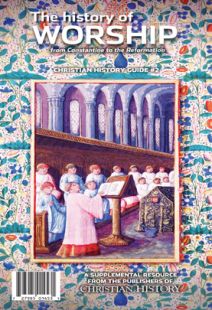Who led worship?
IN THE NEW TESTAMENT and in early church writings such as the Didache, we see a variety of church leadership roles—including wandering prophets. But sometime in the first or second century, a threefold ordained ministry began to emerge: bishops, presbyters (priests), and deacons. the bishop was the governmental and sacramental center of the church in any given location—the chief preacher and administrator of the eucharist. Presbyters administered the sacraments under the bishop’s direction. Deacons assisted in the sacraments and in acts of mercy and outreach including caring for the sick and poor.
Entering leadership
The Apostolic Tradition document, which appears to describe early third-century practice, though it may be as late as the fourth century, gives a model for ordination. the church first approved those candidates who had the gifts and graces for their ministries. then the bishop and, in some circumstances, other leaders laid hands on the candidates and prayed over them. Interestingly, those “confessors” who had been imprisoned on account of their faith during periods of persecution received no further ordination rites unless they desired to become bishops; their “ordination in blood” and sacrifice was enough. Deaconesses, who were especially important in preparing female converts for baptism and in performing acts of mercy to women and children, were ordained for this role in the east although not in the west.
This does not, however, mean that ordained clergy were the only people involved in worship. The Apostolic Tradition distinguishes the roles in church leadership—liturgical and otherwise—of “widows, readers, virgins, sub deacons and healers.” In addition, almost any service would have featured church musicians (see “what sorts of music did worshipers use?,” p. 20). soon four “minor orders”—porters (doorkeepers), lectors, exorcists, and acolytes—began to develop, largely with liturgical functions, and ordination rites were developed for them. Originally these rites simply consisted of giving the ordinands tools symbolic of their trades: keys, books of lessons, books of exorcisms, and candles.
The “major orders” comprised subdeacons (basically deacons-in-training), deacons, and priests. Ordination to these orders included a pledge of celibacy as well as the act of tonsure (cutting of the hair).
Limiting women
Women participated in various roles in worship leadership, including serving as musicians, readers, and deaconesses. Several of the heretical groups that grew up on early Christianity’s fringes allowed women full sacramental powers, and this led the orthodox Catholic Church to limit the roles women could take in leading worship.
The move from house churches under persecution to churches in public spaces under Constantine also contributed to this shift. A Roman matron might exercise great authority over a church gathered within her household, but there were certain ways Roman women were expected to behave, and not behave, in public. Increasing attention was paid to how women arrived at church, acted in worship, dressed, and wore their hair: one Syrian church order forbade women from wearing jewelry to worship or receiving the Eucharist if their hair was artificially curled. Ambrose (d. 397) told virgins not to sigh, clear their throats, cough, or laugh during worship services.
The later middle ages brought little change to these basic structures of church order, only greater ceremony in the methods of ordination and the continued growth of monasteries and convents, where much daily medieval worship was centered. While laypeople might attend services in a monastery or (less likely) convent chapel, they would not have engaged in leadership roles in the services. CH
By Jennifer Woodruff Tait
[Christian History originally published this article in Christian History Issue #102+ in 2012]
Next articles
What did the worship space look like?
Constantine changed church architecture
Jennifer Woodruff TaitWorship at the eve of the Reformation
Medieval people went to church to hear, to taste, to smell, and to see
Jennifer Woodruff TaitClothes fit for a bishop
What the well-dressed bishop wore in the Middle Ages
Reprinted from the Oxford History of Christian WorshipSupport us
Christian History Institute (CHI) is a non-profit Pennsylvania corporation founded in 1982. Your donations support the continuation of this ministry
Donate



